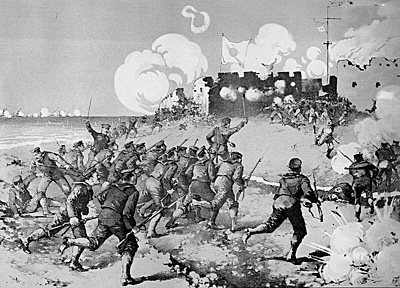 One hundred years ago, in June 1900, China was torn apart by a bloody uprising instigated by the feared Boxer rebels. The conflict, the plight of Western civilians in China and the subsequent Western and Japanese intervention dominated the media of the time and heralded a bloody beginning to the twentieth century.
One hundred years ago, in June 1900, China was torn apart by a bloody uprising instigated by the feared Boxer rebels. The conflict, the plight of Western civilians in China and the subsequent Western and Japanese intervention dominated the media of the time and heralded a bloody beginning to the twentieth century.
An exciting new book combines rare first-hand accounts with incisive historical commentary to paint a picture of the entire course of the rebellion, from the opening shots in June to the Allied occupation of 1901. The book is: CHINA, 1900: THE EYEWITNESSES SPEAK: The Boxer Rebellion as Described by Participants in Letters, Diaries and Photographs by Frederic A. Sharf and Peter Harrington
Accounts by soldiers and civilians describe the rise of the Boxers; the dispatch of the Seymour Expedition and its ultimate failure; the dramatic 55-day siege of Peking; the taking of Tientsin by the Allied Expeditionary force; and the eventual relief and occupation of Peking.
Captain Edward H. Bayly of the Royal Navy, one of the eyewitnesses whose experiences shed light on the events of 1900, was in charge of British military personnel during the Allied relief of Tientsin, besieged by the Boxers in June and July 1900. Here he describes, in his Journal, an early part of the action:
- Tuesday June 19, 1900. Proposal to leave Tientsin, and 'seek a better military base' nearer Taku, was made to me, and distinctly declined. (Letter from M. subsequently called this matter up) – It was never reported 'officially', but was known to a very few, and letter proves it, if proof should ever be wanted. Letter is in my possession. Nice kettle of fish would have resulted if Tientsin had been abandoned. Legations could have fallen, and Admiral's force been cut off, as Chinese could have turned full attention to these objects.
In additions to guns in City, the enemy early placed two small guns (field guns) to the eastward of British Concession, close to railway embankment, between the compounds of two buildings formerly occupied by some railway officials, which opened fire on the Concession, causing much annoyance. An attempt to surprise these was made by a party under Commander Beatty, the Russians promising to make a flank attack from railway station. The attacking party crossed the river and under cover of the houses reached a space under fair cover by a few houses and trees, not much exposed to the guns, if at all. Here they halted, waiting for the flank attack to develop.
The Russians took some time working out from Station, under cover of lines of carriages and trucks, and while the front attack was waiting, a large force of Chinese had worked round under cover of the railway embankment and a mud wall, and taken up a position on right flank of attack, completely enfilading them, on opening fire. This they did with the effect of causing serious casualties.
The surprise having failed, and any chance of success having disappeared, the attacking force withdrew, and the Chinese finding the position of guns untenable in face of increasing accuracy of fire from 9-pounders on Bund, withdrew them, having brought up horses or ponies from under cover, but not before dangerously wounding Lieutenant Wright of Orlando, who was on the Consulate roof, directing the gun, reporting each round. A shell exploded alongside gun, pieces flying up over Consulate, and a portion of Lieutenant Wright's skull was carried away. The services of a most valuable officer were thus lost to the defence, and since, most unfortunately, to the Navy, as after undergoing two operations and apparently making a marvellous recovery, he was invalided home, but succumbed months later under another operation. Wright and I had only changed places a few minutes when he was hit by shell which shook us up at gun. ...
Thursday June 21, 1900. A heavy bombardment. Having only the abominable 9-pounder ML field gun and 16-pounder QF available, can do little to annoy or silence guns in Native City. The black powder smoke gives away the 9-pounder, and its range is poor. The 6-pounder QF is useful in scattering parties of Chinese to the westward. The Wool Mills were set on fire by shell, and burnt out. This deprived us of an excellent signal station, as only the walls of the tower were left, all stairs and inside destroyed. One Chinese, identified by Belgians from Paoting Fu, shot.
Frederic A. Sharf and Peter Harrington are the authors of "A Splendid Little War": The Spanish-American War, 1898 and Omdurman, 1898: The Eyewitnesses Speak. Frederic Sharf has also written The Boxer Rebellion, the catalogue of the art exhibition, in America, to mark the conflict's centenary.
Back to Greenhill Military Book News No. 98 Table of Contents
Back to Greenhill Military Book News List of Issues
Back to Master Magazine List
© Copyright 2000 by Greenhill Books
This article appears in MagWeb (Magazine Web) on the Internet World Wide Web.
Other military history articles and gaming articles are available at http://www.magweb.com